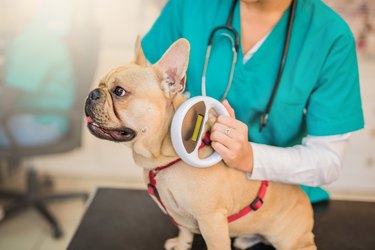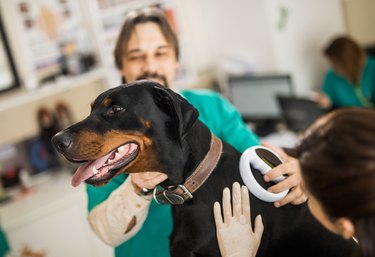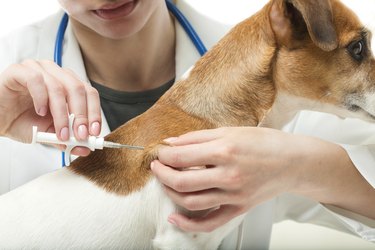Losing your dog is just about the worst thing that could happen. That's why dog owners invest in microchips, a tiny electronic chip that veterinarians implant in the subcutaneous tissue along the spine between a dog's shoulder blades.

When someone finds a lost dog and takes them into an animal shelter, rescue organization, or veterinarian, these places can scan the dog's microchip, look him up in the microchip registries through the American Animal Hospital Association's AAHA Universal Pet Microchip Lookup Tool and attempt to locate your contact information.
Video of the Day
Video of the Day
A microchip is an insurance policy for pet owners, just in case a dog's collar comes off when he gets lost. According to the American Veterinary Medical Association, dogs that do not have microchips are returned to their owners 21.9% of the time, while dogs with microchips are returned 52.2% of the time.
If you have a rescue dog and you can't tell if he is microchipped, or you don't remember if you got your dog microchipped when he was a puppy, then there is a simple solution to this issue.
READ MORE: Why Do I Need Dog Identification Tags?
How do you know if your dog is microchipped?
You can tell if your dog is microchipped simply by taking him to the vet or the rescue organization where you got him. You can ask them about using a universal scanner for a microchip, and they should be able to do it on the spot. The microchip is about the size of a grain of rice, so it is possible you might feel one under the skin.
If your dog does not have a microchip, you can have one put in. Microchipping should cost around $50 and it will, most likely, last throughout your dog's life. A microchip is safe and the procedure is fast and virtually painless. AKC Reunite is a found pet program that enrolls your dog's microchip for life for only $19.50.

How to register your pet's microchip
Once you get the microchip implanted, microchip registration is the next most important step. You have to attach your contact information to your pet's microchip number and add it to the registry's website. There, you'll provide your dog's name, weight and other identifying features, your name, address, phone number, and email. You should also be able to include a secondary address, phone number, and email just in case. You'll be given a little tag you can place on your dog's collar with the chip number and the name of the registry, too.
If you move, or change your phone number or email address, you should update your contact information with your microchip registry. This ensures that if your dog gets lost, the people who find will be able to contact you.
When should you microchip your dog?
You can microchip your dog at any time. When you adopt a dog, the rescue organization will often microchip him for you. It doesn't matter how old your dog is, as long as he is in good health and will be able to undergo the procedure.
If a dog comes into a rescue organization and the owner never claims him, then the organization can clear the information in the microchip, and you can update it with your contact information instead.
If your dog has two microchips for any reason, you don't have to worry that their frequencies will interfere with each other. Some people think that the microchip acts as a GPS device, which can locate your dog if they are lost. That's not what the microchip does. The microchip company can't track your animal's location like a GPS device; it simply holds on to the dog's owner information so that any who has found animals with a chip can locate you.
READ MORE: How Do Dogs Know They are At Vet Clinics?

Preventing your dog from getting lost
Along with getting your dog microchipped and making sure to update your contact information if you have to, you should always keep a collar on your dog with up-to-date ID tags, lock up the gate when he's outside, and use positive training to command him to come when you call out his name. If your dog does get lost – whether or not he's microchipped – you can hang up flyers around your neighborhood, enlist your neighbors' help to look for him, post on Nextdoor, call local shelters and animal organizations and look at lost pet groups on Facebook.
Conclusion
A microchipped pet has a much higher change of being reunited with its owner. In addition to implanting a microchip, registering your pet with a microchip registry and updating your contact info are other important steps.
You can find out if your dog is microchipped by having a veterinarian or rescue organization use a microchip scanner on your dog. If they're not chipped, you can have a microchip put in by the vet, or if they have a chip, you can update your contact information in order to keep your dog safe.
Always check with your veterinarian before changing your pet’s diet, medication, or physical activity routines. This information is not a substitute for a vet’s opinion.